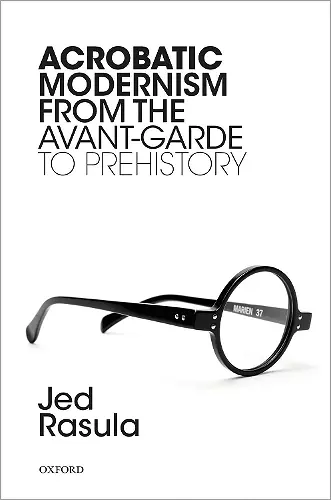Acrobatic Modernism from the Avant-Garde to Prehistory
Format:Hardback
Publisher:Oxford University Press
Published:12th Mar '20
Currently unavailable, and unfortunately no date known when it will be back

This is a book about artistic modernism contending with the historical transfigurations of modernity. As a conscientious engagement with modernity's restructuring of the lifeworld, the modernist avant-garde raised the stakes of this engagement to programmatic explicitness. But even beyond the vanguard, the global phenomenon of jazz combined somatic assault with sensory tutelage. Jazz, like the new technologies of modernity, re-calibrated sensory ratios. The criterion of the new as self-making also extended to names: pseudonyms and heteronyms. The protocols of modernism solicited a pragmatic arousal of bodily sensation as artistic resource, validating an acrobatic sensibility ranging from slapstick and laughter to the pathos of bereavement. Expressivity trumped representation. The artwork was a diagram of perception, not a mimetic rendering. For artists, the historical pressures of altered perception provoked new models, and Ezra Pound's slogan 'Make It New' became the generic rallying cry of renovation. The paradigmatic stance of the avant-garde was established by Futurism, but the discovery of prehistoric art added another provocation to artists. Paleolithic caves validated the spirit of all-over composition, unframed and dynamic. Geometric abstraction, Constructivism and Purism, and Surrealism were all in quest of a new mythology. Making it new yielded a new pathos in the sensation of radical discrepancy between futurist striving and remotest antiquity. The Paleolithic cave and the USSR emitted comparable siren calls on behalf of the remote past and the desired future. As such, the present was suffused with the pathos of being neither, but subject to both.
History of Shiver: The Sublime Impudence of Modernism and Acrobatic Modernism from the Avant-Garde to Prehistory are companion volumes carving forking paths from early German Romanticism through Wagnerism to the proliferation of international avant-gardes and the global convulsions of jazz before following the ungrounding of these upheavals back to prehistoric precedents in cave painting, reading modernism as a "renaissance of the archaic." With the prodigious and perhaps unprecedented range and variety of materials these volumes convene across nine hundred pages, Rasula has demonstrated that it is indeed possible to develop a research practice and a prose style adequate to the sheer profusion of modernist precedent. * Nathan Brown, Boundary 2 *
Rasula's knowledge is impressively vast, covering different languages, media, and disciplines. this knowledge allows him to cast his net wide and present wonderfully startling connections. * Angela Frattarola, Modern Language Review *
Rasula (Univ. of Georgia) provides a fresh and invigorating account of modernism that resists definition or taxonomy and is instead dense with quotations, examples, and information. Rasula spans Europe, North America, Latin America, and East Asia, and traces affinities and influences among music, painting, sculpture, architecture, and literature. ... This book shines new light on a vast topic many have thought already illuminated. * G. Grieve-Carlson, CHOICE *
ISBN: 9780198833949
Dimensions: 236mm x 161mm x 33mm
Weight: 874g
480 pages